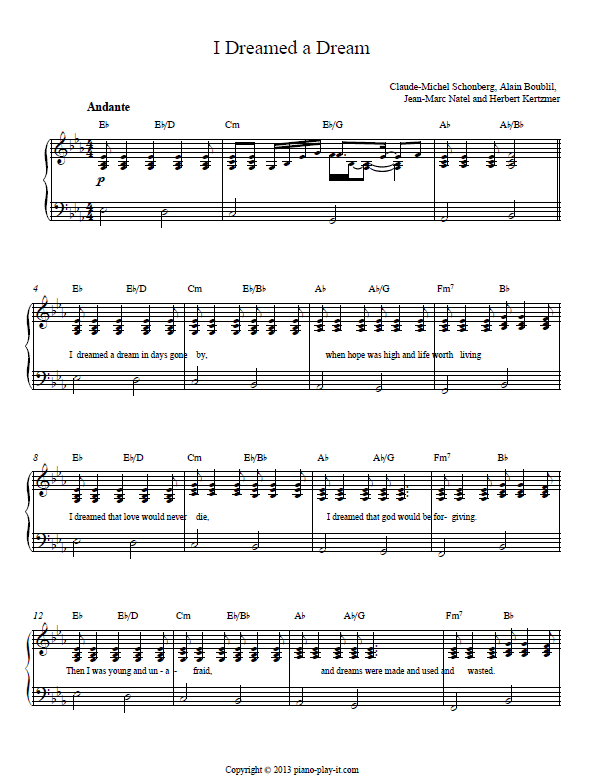“I Dreamed a Dream,” a poignant anthem from the musical Les Misérables, has captivated audiences since its debut. The evocative lyrics, coupled with hauntingly beautiful melodies, create an emotional resonance that resonates deeply with listeners. For aspiring musicians, mastering the chords to this classic piece can seem daunting. However, with a structured approach and some dedication, playing this beloved song can become an attainable goal.
To begin, it’s essential to familiarize oneself with the song’s harmonic structure. “I Dreamed a Dream” primarily utilizes a combination of major and minor chords, which contributes to the song’s dramatic flair. The song’s key is originally in E major, but transposing to a more comfortable key is an option for those who may find certain sections challenging.
Understanding the Chords
The core chords used in the song include E major, C# minor, G# minor, A major, and B major. Each of these chords plays a significant role, not only in defining the song’s character but also in creating a lush harmonic framework. Let’s break down these chords:
- E Major: This chord serves as the song’s tonal center. It establishes a bright and uplifting foundation, drawing listeners into the narrative.
- C# Minor: Often associated with a more somber mood, this chord reflects the deeper emotional undercurrents of the song.
- G# Minor: This minor chord adds a layer of complexity, transitioning smoothly between moods and enhancing the melancholic themes.
- A Major: Known for its resonant quality, this chord injects a sense of hope and optimism into the progression.
- B Major: This dominant chord introduces tension before resolving back to the E major, creating a satisfying musical resolution.
To master these chords, begin with isolated practice. Strumming or arpeggiating each chord while paying attention to hand positioning will build muscle memory. It’s advisable to practice transitioning between chords in different sequences, as this will make the song feel more natural as you play.
Chord Progressions
The song’s structure often revolves around particular chord progressions that define its segments. The most recognizable progression follows a simple yet effective pattern: E - C#m - G#m - A - E - B. This sequence repeats throughout the verses and is foundational for comprehending the song’s form. Understanding the context of each progression is vital for both interpretation and performance.
The verses generally maintain a melancholic yet hopeful vibe, as the protagonist reflects on lost dreams. The chorus intensifies the emotion, amplifying the longing and despair encapsulated within the lyrics. Recognizing this dynamic will aid in articulating the mood as you play.
Techniques for Playing
Beyond just playing the chords, employing various techniques can elevate your rendition of the song. Consider the following:
- Strumming Patterns: Experimenting with different strumming patterns can add nuance to your performance. A soft down-down-up-down-up can create a tender atmosphere, while a more vigorous pattern can inject urgency.
- Arpeggiation: Playing the chords as arpeggios will introduce a more intricate texture. Focusing on one note at a time allows the harmonic richness to shine through, capturing the listener’s attention.
- Dynamics: Paying attention to dynamics—playing some sections softer and others more forcefully—will create a captivating ebb and flow in your performance.
- Use of Pedal: For keyboard players, utilizing the sustain pedal appropriately will create a legato effect, allowing notes to glide smoothly into one another, enhancing emotional depth.
Incorporating Your Style
Once comfortable with the basic chords and techniques, personal expression becomes an integral aspect of your performance. Consider the following points:
- Interpretation: Every musician brings their own interpretation to a piece. Reflect on what the song means to you and how that can be conveyed through your playing style.
- Improvisation: Once you have mastered the basic structure, experimenting with embellishments, such as additional notes or altered rhythms, can create a unique rendition.
- Collaboration: Playing “I Dreamed a Dream” with others can provide fresh perspectives. Consider accompanying a vocalist, or even arranging it for a small ensemble.
Practice Strategies
Consistent practice is key to mastering the chords and techniques associated with this song. Here are some strategic approaches:
- Bite-Sized Learning: Break the song down into smaller sections. Focus on mastering the first verse before moving on to the chorus. This incremental approach minimizes overwhelm.
- Regular Repetition: Dedicate time each day to practice, even if only for a short duration. Regularity fosters familiarity and confidence.
- Record Your Sessions: Recording your practice can provide insights into areas that require improvement. Listening back allows you to critique your performance objectively.
- Setting Goals: Establish specific milestones you wish to achieve, whether it’s perfecting a chord transition or mastering the dynamics. This targeted focus will lead to progressive enhancement.
Conclusion
I Dreamed a Dream stands as a testament to the power of music to convey emotion and narrative. Through an understanding of its chords, a focus on technique, and an infusion of personal interpretation, anyone can bring this piece to life. While learning may seem arduous, each practice session builds intimacy with the song and ultimately transforms it into a truly enchanting experience. Embrace the journey, and allow the music to speak in its timeless, profound way.

